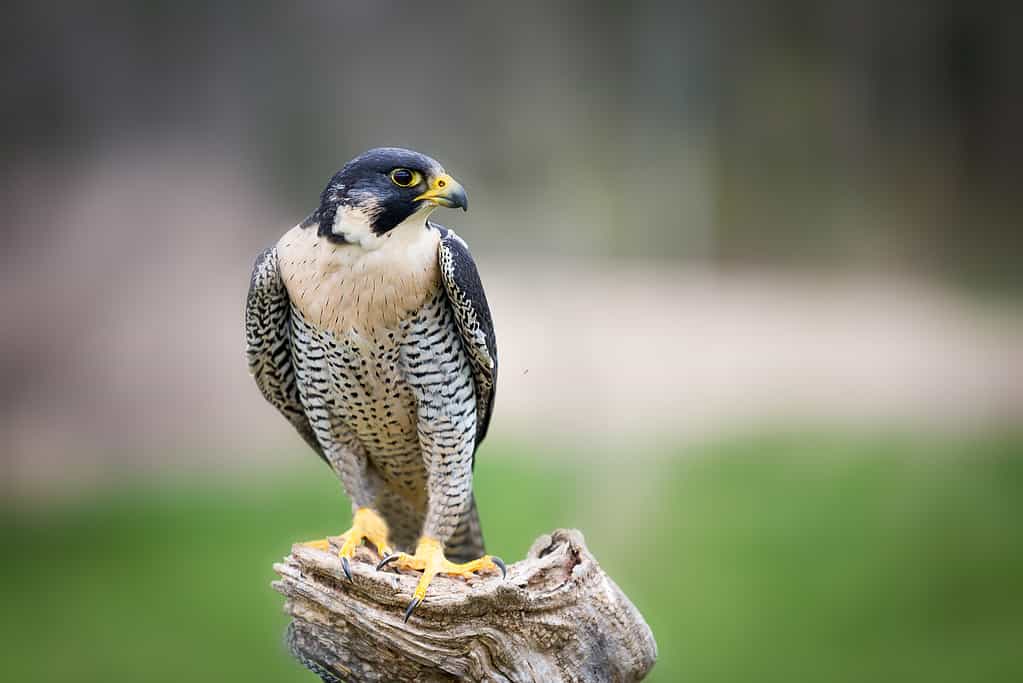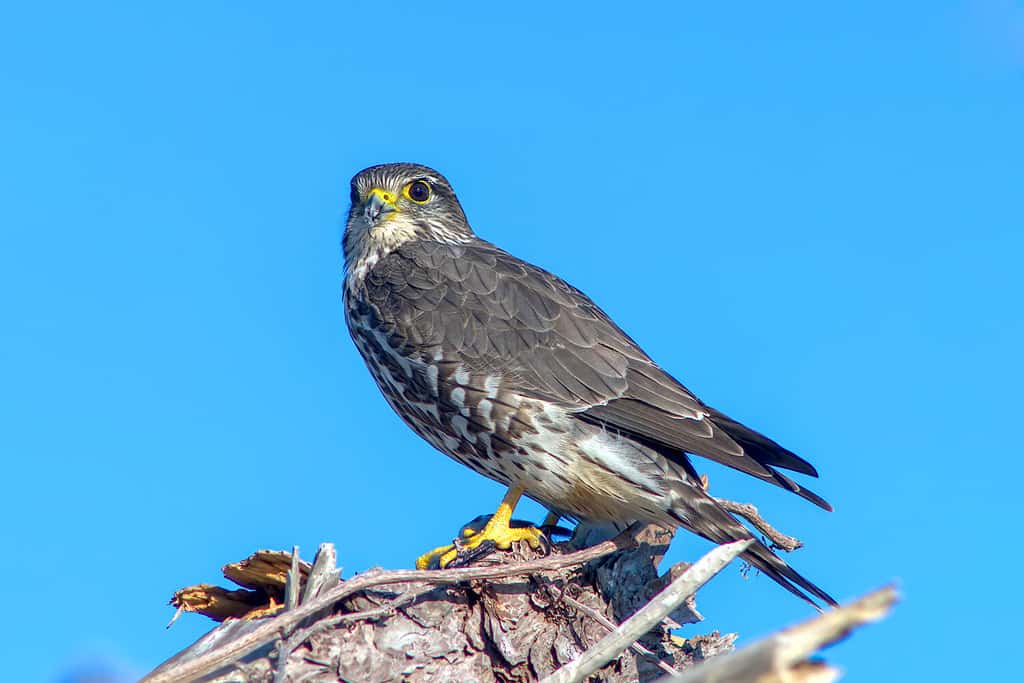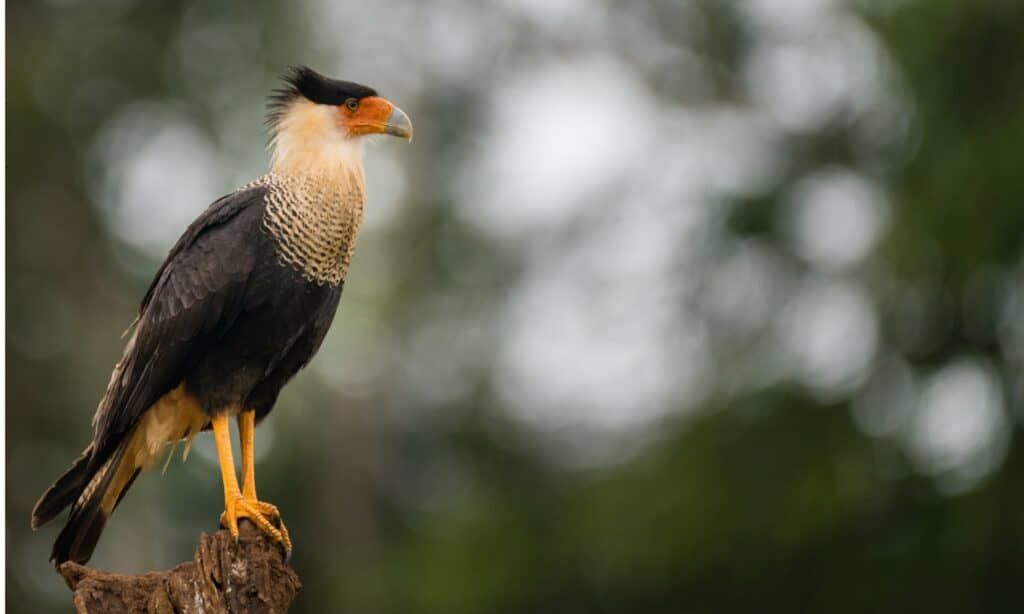Florida is a second home to a myriad of winter visitors. More than just humans and songbirds, however, the state is a winter haven for several species of falcons. In this article, we’ll introduce the four types of falcons in Florida and find out how to identify them. We’ll also talk about where to find these fierce and majestic birds, as well as highlight some of the behaviors and abilities that make each one unique!
1. American Kestrel (Falco sparverius & ssp. paulus)

The American kestrel is the continent’s most colorful falcon!
©mynewturtle/Shutterstock.com
Being the most common falcon in North America, the American kestrel is a staple of Florida’s woodland ecosystems. The species is quite easy to identify by its colorful plumage. Both sexes display bright orange base coloration, pale undersides, and prominent black bars on their wings and tails. They also have grey caps and black stripes on their faces. To differentiate between the sexes, look for the male’s distinct, black chest spots and blue-gray wings.
In addition to being the most common falcon on the continent, the American kestrel is the smallest. Standing between 9 and 12 inches tall and attaining wingspans of only about 24 inches, these birds of prey are quick and nimble. They have to be to avoid predation by larger hawks, falcons, and crows. Don’t let their diminutive size fool you, however — these birds are still fierce predators.
Most populations of American kestrels migrate, arriving in Florida late in the year to overwinter and leaving in the spring. Some populations, however, remain in the state year-round. These birds, the southeastern American kestrels, belong to their subspecies, Falco sparverius paulus. Due to habitat loss and expansion of human settlements, their southeastern distribution has shrunken considerably. Today, these kestrels reside almost exclusively in Florida but can still be found in the coastal plains of the surrounding states. Physically, they are nearly impossible to distinguish from their migratory relatives. However, if you spot a kestrel during the spring and summer, from May to September, you can be certain it’s the southeastern variant.
Today, to help preserve the southeastern American kestrel, the Florida Fish and Wildlife Conservation Commission has instituted a nesting box program that aims to provide these birds with crucial nesting sites.
2. Peregrine Falcon (Falco peregrinus)

Though their populations have historically suffered, peregrine falcons are making a comeback today thanks to decades of conservation.
©emranashraf/iStock / Getty Images Plus via Getty Images
While the American kestrel is unique in terms of size, color, and distribution, the peregrine falcon holds its first-place rank. Members of this species are the fastest birds on the entire planet. To capture their prey, peregrine falcons can dive from the skies at speeds exceeding 200 miles per hour! Even more impressively, the prey they are chasing at these neck-breaking speeds is airborne!
If you want to spot a peregrine falcon, you’ll need to look up. Not only do they spend a lot of time in the air, but they also tend to perch high up on tall buildings, radio and water towers, and bridges. These birds do not nest or reproduce in Florida, so you can’t rely on nesting locations to spot one. Before they migrate south for the winter, peregrine falcons nest high on rocky cliffs, ledges, and overhangs. They are not nest-builders, however. Generally, they scratch indents into the dry soil or lay eggs in tucked-away spaces in their chosen manmade structures. In some cases, like other falcons, they will reuse abandoned nests of other bird species.
If you’re looking up, you may see these birds silhouetted against the sky. There, they are easy to identify by their large size and narrow tails, as compared to the fanned-out tails of hawks. Closer, however, you’ll notice their dark, slate-grey back plumage and black spots and bars on their white undersides. They have yellow coloration surrounding their nares, just behind their dark, hooked beaks. You may even see one mid-dive if you’re very lucky!
For several decades, peregrine falcons have suffered declines due to the widespread use of pesticides like DDT. Accumulation of these chemicals in their bodies caused loss of fertility, egg fragility, and reduced chick survival. They are still a relatively uncommon sight in the wild. However, with great conservation efforts, their populations have been on the rise!
3. Merlin (Falco columbarius)

In the winter, merlins travel to Florida from the forests of the far north. Many spend their vacation along the coasts chasing down shorebirds.
©Noah Li/Shutterstock.com
A bit larger than the American kestrel, the merlin is the second-smallest of the falcons in Florida. These compact birds are swift and efficient predators as well, capturing their prey mid-flight. Rather than dive like the peregrine falcon, however, merlins tend to perch in wait, watching for the perfect prey. They mostly feed on small birds, depending on availability, but will chase down aerial insects and even bats. While it may be hard to imagine a large bird catching a fleeting bat, consider that they can fly at speeds greater than 30 miles per hour!
Merlins are stately birds. They appear across the country with different color variations depending upon the region they inhabit. The ones you’ll find in Florida are known as the taiga merlins, who migrate south in the winter from the northern forests. They have blue-grey or silver-grey backs, with coloration extending over their heads and large eyes like a cowl. Their breast plumage is largely white or off-white and is broken up by many dark spots and bars, which extend to the underside of their striped tails. Both their talons and beak, as well as their eyes, tend to be a bright yellow, lending them a splash of color.
These birds spend most of the year outside of the state, appearing only during the winter months. They are a very common sight along the coast, but can also be found in open woodlands, grasslands, and fields where they can get a clear line of sight toward their prey. If you don’t see one actively chasing a smaller bird, look upward into the treetops.
4. Crested Caracara (Caracara plancus cheriway)

The crested caracara is unique from the other three falcons in Florida, in appearance, behavior, and lineage.
©iStock.com/AdamMajor
The final of the four types of falcons in Florida is the crested caracara. At first glance, you might guess that this bird is a closer relative of the hawks or vultures than it is of the falcons. Its long legs, exceptionally thick beak, and taste for carrion may certainly give that impression. However, this bird resides firmly within the family Falconidae.
These powerful birds have the characteristically intense eyes and hooked talons of other falcons as well as striking, high-contrast plumage that makes them stand out from their environment. Compared to other falcon species, these birds are quite large. They can grow to nearly 2 feet in height and attain wingspans of nearly 4 feet across!
The crested caracara also exhibits unique nesting behavior. While other falcons reuse the abandoned nests of other birds to raise their young, the crested caracara builds its own each year. From September to April, you may see them nesting high in the surrounding trees.
The fact that the crested caracara appears in Florida is quite amazing. Though they do show up in the southwestern U.S. in states like Texas and California, Florida represents the northeastern extent of its range. Most of these birds reside in open, lower-altitude habitats in Mexico and Central and South America. If you’re looking to spot one in the wild, you’ll have the best shot in prairies or woodlands in the south-central portion of the state. Look in prairies or open woodlands with cabbage palms, saw palmettos, cypress, or scrub oaks. These birds are quite confident and do not shy away from human observers.
The photo featured at the top of this post is © FotoRequest/Shutterstock.com
Thank you for reading! Have some feedback for us? Contact the AZ Animals editorial team.







